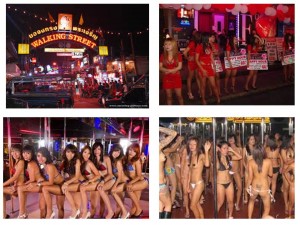My good lady wife and I have been spending part of the British winter in a beach resort just a vigorous stone’s throw away from one of the world’s most famous sin cities, which I’ll call HappyHappyTown. HappyHappyTown started it’s rise to ‘fame’ during the Vietnam War when US troops went there for R&R. When that ended, there were floods of sex tourists from Europe, USA and Australia and HappyHappyTown grew rapidly from a small fishing village into a major city with hundreds of establishments from gogo bars to bj-bars offering all kinds of services.
But recently, things haven’t been going so well in HappyHappyTown.
For any business to operate well you have to manage supply (having things to sell) and demand (finding customers who want to buy what you’re selling). And HappyHappyTown is having problems on both fronts:
Supply: For the last 40+ years, there has been a seemingly unlimited supply of RFFMs coming from the country’s impoverished rice-farming North. But now, as girls are getting better education, they no longer want to work in the ‘entertainment’ business. This has meant that the gogo bars and bj-bars have been struggling to recruit sufficient girls and are fighting over the few girls that are available. This has meant a sharp rise in salaries and the bankruptcy of several bars.
Demand: With most European countries in economic difficulties, there has been a sharp drop in Western sex tourists. Over the last few years, there has been a massive increase in Russian tourists to the Land of Smells. But with the ruble turning into rubble, these have dropped off too. Moreover, most of the Russians come as families, not for sex tourism. The area where there has been growth in sex tourism is from India and the Middle East. But they tend to get their girls either from night clubs or from the main prostitutes’ strip, not from gogo bars.
The other group of tourists that has seen a massive rise are the Chinese. But they come in huge groups, scuttle off their coaches like a crowd of cockroaches, waddle along following their tour leaders constantly filming with their cameras and selfie-sticks and then scuttle back into their coaches leaving behind a long trail of saliva and muccus (as they seem to spit and clear their noses everywhere they go). But they tend to never actually enter any gogo bars.
The result: The standard model here was a girl would work in a gogo bar earning about 15,000 baht a month (�300) for dancing 6 days a week from about 20.00h to 03.00h.
But she would increase her income by cadging drinks from customers (�1 per drink for her) and from ‘short time’ – having sex with a customer for about 2,000 baht (�40). In a reasonable month a girl could be taking at least 60,000 baht (�1,200). Due to the lower cost of living here, you have to multiply by at least five to get an idea of their real earnings. So, in a month a girl could be getting the equivalent of �6,000 taxfree. Five years of that and she has probably saved up enough to buy a small business – a shop or house with rooms for rent – and can retire.
But with the fall in gogo bar customers and the rise in the numbers of Indian and Middle East sex tourists, the girls in the gogo bars aren’t earning nearly as much as they used to. In fact, many gogos seem nearly empty a lot of the time. So the girls who still want to work in ‘adult entertainment’ are abandoning gogo bars and going freelance. After all, if they can earn 60,000 to 70,000 baht a month from just 2 to 3 customers a day, why bother exhausting themselves for 7 hours a day dancing on ridiculously high heels in a gogo bar?
At least 15 gogo bars have gone out of business in the last couple of years and more are expected to go to the wall in the next few years.
Behind the bright lights and loud music, things in one of the world’s greatest sex paradises are looking decidedly flaccid.
(Regarding the NHS – a reader asked yesterday if I had any figures comparing the number of managers in health services in other countries to the NHS. I have tried to find this several times, but without success. However, my first wife was a breast-cancer surgeon in a small European country. In her unit, which was quite a large department with five specialised surgeons, there were no managers. Instead it was up to the head of the department – a surgeon – working with the other surgeons to decide how much of their budget they wished to spend on administrative support. In fact, I think the surgeons would have been astonished if anyone actually suggested spending up to �100,000 a year of their budget on a manager for their department. The main hospital did, of course, have central management and administration. I imagine a specialised unit like that in Britain, would have at least 2 to 3 overpaid, over-pensioned and mostly unnecessary managers. But in that country the surgeons couldn’t see the need for any managers at all.)
(by the way, my latest book THE GREAT CHARITY SCANDAL is now available as a short paperback for just around 4 quid�http://www.amazon.co.uk/The-Great-Charity-Scandal-Billions/dp/1872188117/ref=tmm_pap_title_0 )















Leave a Reply